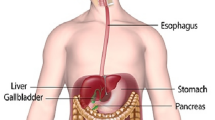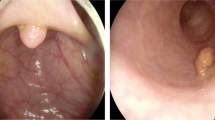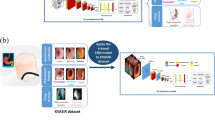Abstract
Gastrointestinal endoscopy is the primary method used for the diagnosis and treatment of gastric polyps. The early detection and removal of polyps is vitally important in preventing cancer development. Many studies indicate that a high workload can contribute to misdiagnosing gastric polyps, even for experienced physicians. In this study, we aimed to establish a deep learning–based computer-aided diagnosis system for automatic gastric polyp detection. A private gastric polyp dataset was generated for this purpose consisting of 2195 endoscopic images and 3031 polyp labels. Retrospective gastrointestinal endoscopy data from the Karadeniz Technical University, Farabi Hospital, were used in the study. YOLOv4, CenterNet, EfficientNet, Cross Stage ResNext50-SPP, YOLOv3, YOLOv3-SPP, Single Shot Detection, and Faster Regional CNN deep learning models were implemented and assessed to determine the most efficient model for precancerous gastric polyp detection. The dataset was split 70% and 30% for training and testing all the implemented models. YOLOv4 was determined to be the most accurate model, with an 87.95% mean average precision. We also evaluated all the deep learning models using a public gastric polyp dataset as the test data. The results show that YOLOv4 has significant potential applicability in detecting gastric polyps and can be used effectively in gastrointestinal CAD systems.
Graphical abstract
Gastric Polyp Detection Process using Deep Learning with Private Dataset






Similar content being viewed by others
References
GLOBOCAN. Global Cancer Observatory, International Agency for Research on Cancer. World Health Organization. 2018. https://gco.iarc.fr/today/home. Accessed 10 OCTOBER 2020
Billah M, Waheed S, Rahman MM (2017) An automatic gastrointestinal polyp detection system in video endoscopy using fusion of color wavelet and convolutional neural network features. Int J Biomed Imaging 2017:9545920
Gotoda T (2006 Sep) Endoscopic resection of early gastric cancer: the Japanese perspective. Curr Opin Gastroenterol 22(5):561–569
Katai H, Ishikawa T, Akazawa K, Isobe Y, Miyashiro I, Oda I et al (2018) Five-year survival analysis of surgically resected gastric cancer cases in Japan: a retrospective analysis of more than 100,000 patients from the nationwide registry of the Japanese Gastric Cancer Association (2001–2007). Gastric Cancer 21(1):144–154
Byrne MF, Chapados N, Soudan F, Oertel C, Pérez ML, Kelly R et al (2019) Real-time differentiation of adenomatous and hyperplastic diminutive colorectal polyps during analysis of unaltered videos of standard colonoscopy using a deep learning model. Gut 68(1):94–100
Ladabaum U, Fioritto A, Mitani A, Desai M, Kim JP, Rex DK et al (2013) Real-time optical biopsy of colon polyps with narrow band imaging in community practice does not yet meet key thresholds for clinical decisions. Gastroenterology 144(1):81–91
Laddha M, Jindal S, Wojciechowski J (eds) (2019) Gastric polyp detection using deep convolutional neural network. Proceedings of the 2019 4th International Conference on Biomedical Imaging, Signal Processing, Nagoya Japan, 17–19 October 2019, pp 55–59. https://doi.org/10.1145/3366174.3366185
Hasan MM, Islam N, Rahman MM (2020) Gastrointestinal polyp detection through a fusion of contourlet transform and neural features. J King Saud Univ - Comput Inf Sci. In Press, Corrected Proof. https://doi.org/10.1016/j.jksuci.2019.12.013
Yanase J, Triantaphyllou E (2019) A systematic survey of computer-aided diagnosis in medicine: past and present developments. Expert Syst Appl 138:112821
Hoogenboom SA, Bagci U, Wallace MB (2019) AI in gastroenterology. The current state of play and the potential. How will it affect our practice and when? TIGE 22(2):42–47. https://doi.org/10.1016/j.tgie.2019.150634
El Hajjar A, Rey J-F (2020) Artificial intelligence in gastrointestinal endoscopy: general overview. Chin Mid J (Engl) 133(3):326–334. https://doi.org/10.1097/CM9.0000000000000623
Lundervold AS, Lundervold A (2019) An overview of deep learning in medical imaging focusing on MRI. Z Med Phys 29(2):102–127
Abadir AP, Ali MF, Karnes W, Samarasena JB (2020) Artificial intelligence in gastrointestinal endoscopy. Clinical endoscopy 53(2):132
Choi J, Shin K, Jung J, Bae H-J, Kim DH, Byeon J-S et al (2020) Convolutional neural network technology in endoscopic imaging: artificial intelligence for endoscopy. Clin Endosc 53(2):117
Hirasawa T, Aoyama K, Tanimoto T, Ishihara S, Shichijo S, Ozawa T, Ohnishi T, Fujishiro M, Matsuo K, Fujisaki J, Tada T (2018) Application of artificial intelligence using a convolutional neural network for detecting gastric cancer in endoscopic images. Gastric Cancer 21:653–660
Wang R, Zhang W, Nie W, Yu Y (2019) Gastric polyps detection by improved Faster R-CNN. ICCPR '19, October 23–25, 2019, Beijing, China
Zhang X, Chen F, Yu T, An J, Huang Z, Liu J et al (2019) Real-time gastric polyp detection using convolutional neural networks. PloS one 14(3):e0214133
Xia J, Xia T, Pan J, Gao F, Wang S, Qian Y-Y et al (2020) Use of artificial intelligence for detection of gastric lesions by magnetically controlled capsule endoscopy. Gastroint Endosc 93(1):133–139. https://doi.org/10.1016/j.gie.2020.05.027
Cao C, Wang R, Yu Y, Zhang H, Yu Y, Sun C (2021) Gastric polyp detection in gastroscopic images using deep neural network. PLoS ONE 16(4):e0250632
Nogueira-Rodríguez A, Domínguez-Carbajales R, López-Fernández H, Iglesias A, Cubiella J, Fdez-Riverola F, Reboiro-Jato M, Glez-Pena D (2021) Deep neural networks approaches for detecting and classifying colorectal polyps. Neurocomputing 423:721–734
Sánchez-Peralta LF, Bote-Curiel L, Picon A, Sánchez-Margallo FM, Pagador JB (2020) Deep learning to find colorectal polyps in colonoscopy: a systematic literature review. Artif Intell Med 108:101923
Pacal I, Karaboga D, Basturk A, Akay B, Nalbantoglu U (2020) A comprehensive review of deep learning in colon cancer. J Comput Biol Med 126:104003
Bochkovskiy A, Wang C-Y, Liao H-YM (2020) YOLOv4: optimal speed and accuracy of object detection. arXiv preprint
Wang C-Y, Mark Liao H-Y, Wu Y-H, Chen P-Y, Hsieh J-W, Yeh I-H, (editors) (2020) CSPNet: a new backbone that can enhance learning capability of cnn. 2020 IEEE/CVF Conference on Computer Vision and Pattern Recognition Workshops (CVPRW), Seattle, WA, USA, 14–19 June 2020, pp 1571–1580. https://doi.org/10.1109/CVPRW50498.2020.00203
Duan K, Bai S, Xie L, Qi H, Huang Q, Tian Q, (eds) (2019) Centernet: keypoint triplets for object detection. 2019 IEEE/CVF International Conference on Computer Vision (ICCV), Seoul, Korea (South), 27 Oct.–2 Nov. 2019, pp 6568–6577. https://doi.org/10.1109/ICCV.2019.00667
Ren S, He K, Girshick R, Sun J, (eds) (2015) Faster r-cnn: towards real-time object detection with region proposal networks. Advances in neural information processing systems 28 (NIPS 2015), Montreal, Quebec, Canada, December 8–13, 2014
Liu W, Anguelov D, Erhan D, Szegedy C, Reed S, Fu C-Y, Berg Alexander C (2016) Ssd: Single shot multibox detector arXiv:1512.02325. https://doi.org/10.1007/978-3-319-46448-0_2
Redmon J, Farhadi A (2018) YOLOv3: An incremental improvement. arXiv:1804.02767
Zhang P, Zhong Y, Li X, (2019). SlimYOLOv3: Narrower, faster and better for real-time UAV applications arXiv:1907.11093. https://doi.org/10.1109/ICCVW.2019.00011
Tan M, Le QV (2019) Efficientnet: rethinking model scaling for convolutional neural networks. arXiv: 1905.11946
Dirschmid K, Platz-Baudin C, Stolte M (2006) Why is the hyperplastic polyp a marker for the precancerous condition of the gastric mucosa? Virchows Arch 448(1):80–84
Lynch HT, Smyrk T, McGinn T, Lanspa S, Cavalieri J, Lynch J et al (1995) Attenuated familial adenomatous polyposis (AFAP) a phenotypically and genotypically distinctive variant of FAP. Cancer 76(12):2427–2433
Worthley D, Phillips K, Wayte N, Schrader K, Healey S, Kaurah P et al (2012) Gastric adenocarcinoma and proximal polyposis of the stomach (GAPPS): a new autosomal dominant syndrome. Gut 61(5):774–779
Vogt S, Jones N, Christian D, Engel C, Nielsen M, Kaufmann A et al (2009) Expanded extracolonic tumor spectrum in MUTYH-associated polyposis. Gastroenterology 137(6):1976–85. e10
Voutilainen M, Mäntynen T, Kunnamo I et al (2003) Impact of clinical symptoms and referral volume on endoscopy for detecting. Scand J Gastroenterol 38:109–113
Burt RW (2003) Gastric fundic gland polyps. Gastroenterology 125:1462–1469
Borch K, Skarsgård J, Franzén L et al (2003) Benign gastric polyps: morphological and functional origin. Dig Dis Sci 48:1292–1297
Xie S, Girshick R, Dollár P, Tu Z, He K (2017) Aggregated residual transformations for deep neural networks. arXiv:1611.05431
Cantor G (1984) Über unendliche, lineare Punktmannigfaltigkeiten, Arbeiten zur Mengenlehre aus den Jahren 1872–1884. Springer-Verlag Wien. https://doi.org/10.1007/978-3-7091-9516-1
He K, Zhang X, Ren S, Sun J (2015) Spatial pyramid pooling in deep convolutional networks for visual recognition. IEEE Trans Pattern Anal Mach Intell 37(9):1904–1916
Bai Y, Yu W, Xiao T, Xu C, Yang K, Ma W-Y et al (eds) (2014) Bag-of-words based deep neural network for image retrieval. Proceedings of the 22nd ACM international conference on Multimedia, New York, NY, USA, pp 229–232. https://doi.org/10.1145/2647868.2656402
Law H, Deng J (eds) (2020) Cornernet: detecting objects as paired keypoints. Int J Comput Vis 128:642–656. https://doi.org/10.1007/s11263-019-01204-1
Newell A, Yang K, Deng J (2016) Stacked hourglass networks for human pose estimation. arXiv:1603.06937
Lin TY, Maire M, Belongie S, Bourdev L, Girshick R, Hays J, Perona P, Ramanan D, Zitnick CL, Dollar P (2015) Microsoft COCO: common objects in context. arXiv:1405.0312
Pham MT, Kim J-M, Kim CH (2020) Intelligent fault diagnosis method using acoustic emission signals for bearings under complex working conditions. Appl Sci 10(20):7068
Tan M, Chen B, Pang R, Vasudevan V, Sandler M, Howard A et al (eds) (2019) Mnasnet: platform-aware neural architecture search for mobile. Proceedings of the IEEE Conference on Computer Vision and Pattern Recognition (CVPR), 2019, pp 2820–2828
Le Duy Huynh NB. A U-NET++ with pre-trained EfficientNet backbone for segmentation of diseases and artifacts in endoscopy images and videos, CEUR Workshop Proceedings 2595, 13–17
Girshick R (2015) Fast R-CNN. Proceedings of the IEEE International Conference on Computer Vision 2015 International Conference on Computer Vision, ICCV 2015, 1440–1448. https://doi.org/10.1109/ICCV.2015.169
Author information
Authors and Affiliations
Corresponding author
Ethics declarations
Ethics approval
All procedures performed in studies involving human participants was approved by the Head of Scientific Research Ethics Committee of Farabi Hospital, Faculty of Medicine, Karadeniz Technical University, Trabzon, Turkey, on 24.07.2020 with the protocol number 2020/165 and the document number 24237859–488. As this is a retrospective study formal consent is not required.
Conflict of interest
The authors declare no competing interests.
Additional information
Publisher’s note
Springer Nature remains neutral with regard to jurisdictional claims in published maps and institutional affiliations.
Rights and permissions
About this article
Cite this article
Durak, S., Bayram, B., Bakırman, T. et al. Deep neural network approaches for detecting gastric polyps in endoscopic images. Med Biol Eng Comput 59, 1563–1574 (2021). https://doi.org/10.1007/s11517-021-02398-8
Received:
Accepted:
Published:
Issue Date:
DOI: https://doi.org/10.1007/s11517-021-02398-8




